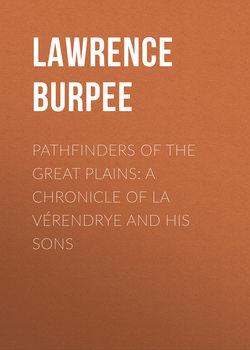Pathfinders of the Great Plains: A Chronicle of La Vérendrye and his Sons

Реклама. ООО «ЛитРес», ИНН: 7719571260.
Оглавление
Burpee Lawrence Johnstone. Pathfinders of the Great Plains: A Chronicle of La Vérendrye and his Sons
CHAPTER I. EARLY SERVICE
CHAPTER II. FIRST ATTEMPT AT EXPLORATION
CHAPTER III. ACROSS THE PLAINS
CHAPTER IV. THE MANDAN INDIANS
CHAPTER V. THE DISCOVERY OF THE ROCKY MOUNTAINS
CHAPTER VI. LA VÉRENDRYES' LATTER DAYS
BIBLIOGRAPHICAL NOTE
Отрывок из книги
Canada has had many brave sons, but none braver than Pierre Gaultier de La Vérendrye, who gave all that he had, including his life, for the glory and welfare of his country. La Vérendrye was born in the quaint little town of Three Rivers, on the St Lawrence, on November 17, 1685. His father was governor of the district of which Three Rivers was the capital; his mother was a daughter of Pierre Boucher, a former governor of the same district. In those days, when Canada was still a French colony, both Three Rivers and Montreal had their own governors, while the whole colony was under the authority of the governor-general, who lived at Quebec.
At that time Three Rivers was a more important place than it is to-day. Next to Quebec and Montreal, it was the largest town in Canada. If we could see it as it was in the days of La Vérendrye, we should find it very different from the towns we know. It was surrounded by a strong wall and protected with cannon. The town had always a garrison of regular soldiers, and this garrison was supported in times of necessity by every man and boy in Three Rivers. Those who lived in the neighbourhood were also liable to be called upon for the service of defence. In those days, when the dreaded Iroquois might at any moment swoop down upon the little settlement, every man kept his gun within reach, and every man knew how to use it. When the alarm was given, men, women, and children swarmed into Three Rivers, and the town became a secure fortress; for the Indians, ready enough to ambush small parties of white men in the forest or in the fields, rarely dared to attack walled towns.
.....
The fur-traders themselves were divided into two classes. The more staid and respectable class built trading forts in the interior on the borders of territories occupied by the Indians. Here they kept a supply of the things required by the natives: guns, powder and balls, tobacco, blankets, bright-coloured cotton, axes and small tools, flints and steels, vermilion for war-paint, and beads of every colour and description. The Indians brought their furs into the forts and bartered them for the goods that they needed. Sometimes, with no sense of real values, they traded beaver skins and other pelts of high worth for a piece of gaudy cotton, a little vermilion, or a handful of beads. The white men, of course, brought things which rapidly became indispensable to the Indians, whose native bows and arrows and hatchets of stone seemed almost useless compared with the muskets and the steel axes brought from Europe. To acquire these things became vital to the Indians, and the traders who now supplied them acquired each year thousands of beautiful furs. These were tied up securely into packs and carried in canoes down to Montreal or Three Rivers, where they were bought by the great merchants and sent by ship to France. The furs that had been bought from the Indian for a mere trifle fetched hundreds of francs when they finally reached Paris.
The second class of traders, known as coureurs de bois, or wood-runners, were very different from the first. Speaking generally, they were young men, sometimes of good family, who found life in the older towns and settlements prosaic and uninteresting, and when they went to the interior did not care to be tied down to the humdrum existence of the trading forts. Instead of requiring the Indians to bring their furs down to some fort, these enterprising rovers of the forest went into the Indian country. Sometimes they took light trading goods with them to barter with the redskins for furs, but oftener they themselves hunted and trapped the beaver, the otter, and the fox. The coureurs de bois were generally men of reckless courage, ready to face danger and hardship. From long living among the savages they themselves became in time half savage. Some of them took Indian wives and were adopted into the tribes.
.....